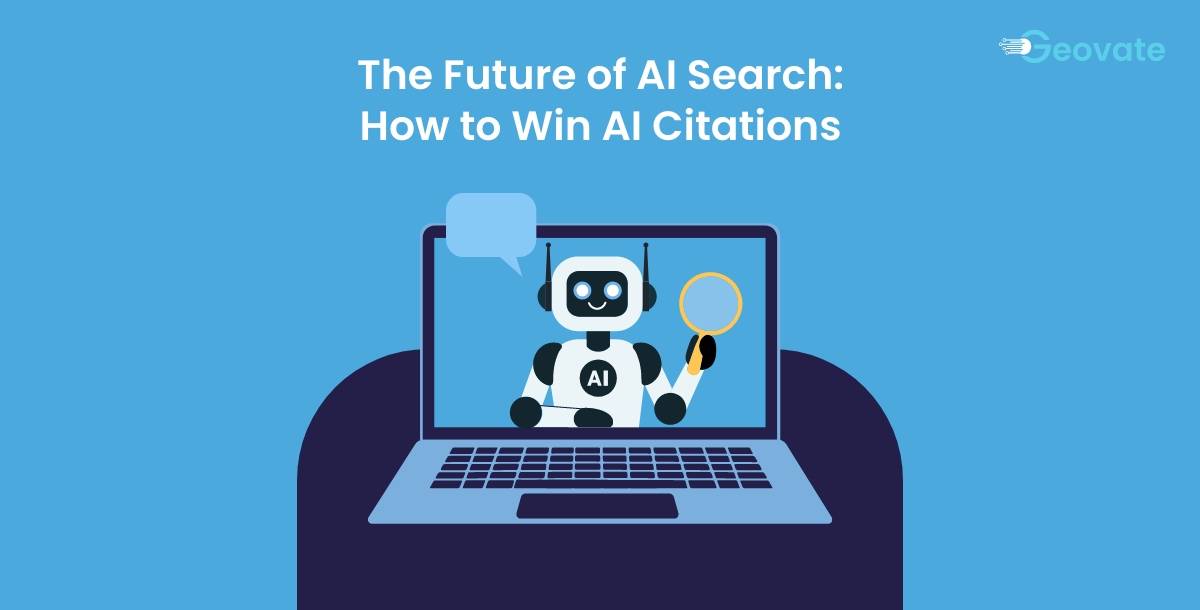The Future of AI Search: How to Win AI Citations in 2025
Fri,03 Oct 2025 15:06:00- Font Size
- Share Content

In 2025, SEO has a new frontier: AI search optimization. Traditional rankings are no longer the only metric that matters. With AI-driven platforms like ChatGPT, Perplexity, Google’s AI Overviews, and Microsoft Copilot becoming the default information sources, your website’s visibility depends on whether AI models choose to cite your content as the answer.
That’s where specialized AISEO Services are changing the game. Instead of focusing only on search engine rankings, these solutions help position your content for AI-driven visibility.
Equally important are AISEO optimization Services, which fine-tune structure, schema, and technical SEO so AI engines can easily parse and select your content for citations.
This guide from Geovate breaks down the latest research on AI citations and shows you how to optimize content to get quoted by AI engines.
Why AI Citations Matter More Than Rankings
AI engines don’t just summarize — they rewrite the search experience. Instead of ten blue links, users now get a conversational, AI-generated answer. In this world:
- If you’re cited, you earn authority, clicks, and trust.
- If you’re not cited, you’re invisible.
The study shows that AI citations don’t follow traditional SEO rules. Traffic, backlinks, and domain authority aren’t the deciding factors. Instead, what matters is content structure, recency, specificity, and technical accessibility.
Different AI Engines, Different Tastes
ChatGPT: The Authority Gatekeeper
ChatGPT favors institutional authority. Think Wikipedia, Forbes, Gartner, Amazon, G2. If you want citations here, your content must:
- Sound like an expert source (formal, authoritative).
- Include data, statistics, and references.
- Avoid “bloggy” or casual tones.
Best for ChatGPT Citations:
Whitepapers, expert guides, research-backed blogs. If you’re wondering how to rank on ChatGPT, the key is to build trust through authoritative, expert-driven content.
Perplexity: The Crowd-Driven Conversationalist
Perplexity thrives on user-generated content (UGC). Reddit threads, YouTube comments, Yelp reviews, LinkedIn posts — anything that reflects authentic human experience.
To win Perplexity:
- Showcase real user testimonials.
- Collect UGC via surveys, reviews, or community forums.
- Embed authentic voices alongside expert content.
Best for Perplexity Citations:
Case studies, testimonials, review roundups. For those asking how to rank on Perplexity, the answer lies in highlighting genuine user voices and community-driven insights.
Google AI Overviews: The Technical Neutralizer
Google’s AI Overviews blend multiple sources — from corporate sites to social posts — but only if your content is technically accessible.
Google AIO doesn’t reward prestige; it rewards clean implementation:
- Server-side rendered pages (no heavy JavaScript).
- Schema markup on FAQs and products.
- Crawlable HTML with keyword-rich slugs.
Best for Google AIO Citations:
Static HTML guides, well-structured listicles, and FAQ-rich articles. If you’re curious about how to rank in Google AI Overviews, the answer is simple: prioritize technical SEO and ensure your content is crawlable in raw HTML.
Microsoft Copilot: The B2B Powerhouse
Microsoft Copilot favors business-oriented sources. Think Gartner reports, PCMag reviews, and enterprise case studies.
To optimize for Copilot:
- Publish B2B comparisons and case studies.
- Highlight ROI, workflows, and productivity outcomes.
- Use industry terms and professional tone.
Best for Copilot Citations:
Enterprise tool comparisons, market analysis, whitepapers.
Why Website Traffic Doesn’t Matter Anymore
The study revealed a shocking truth: high traffic ≠ AI citations.
- Some pages with 12 monthly visits earned 900+ AI citations.
- Meanwhile, 10K traffic homepages got ignored due to technical issues.
The culprit? JavaScript.
AI bots don’t execute JavaScript. If your critical content is loaded via API calls, modals, or dynamic components, AI crawlers can’t see it.
Fix: Use server-side rendering (SSR) for critical pages. With frameworks like Next.js or Nuxt, generate static HTML so AI engines can parse your content.
The Content Format That Wins: Listicles
Why AIs Love Listicles
The research found that 32.5% of all AI citations come from comparative listicles.
- Comparative listicles → 57.6M citations
- Opinion/Analysis → 17.5M
- Product Pages → 8.3M
Why? Because AI engines love structured, easy-to-parse data. A numbered list with clear pros/cons gives them exactly what they need to extract concise answers.
Example:
“7 Best Generative Engine Optimization (GEO) Tools in 2025”
Recency: The Secret Boost Factor
AI engines are indexing new content within 48–72 hours. Freshness signals directly impact citation probability.
How to optimize recency:
- Add “Updated [Year]” to your titles.
- Refresh old posts with new data, timestamps, and schema.
- Republish evergreen content quarterly to maintain freshness.
Micro-Niche Content Beats Broad Topics
Generic content is ignored. Hyper-specific content gets cited.
Bad: “Best Marketing Tools”
Good: “Email Marketing Platforms for SaaS Startups Under 50 Employees”
Bad: “AI in Business”
Good: “How Small Agencies Use AI to Automate Client Reporting”
Action: Create niche, answer-first pages that solve one specific query completely.
The Geovate AI Engine Optimization Playbook
Based on the study’s findings, here’s a step-by-step AEO framework:
1. Structure for AI Crawlers
- Use H2s as questions, answers in 1–2 sentences.
- Add FAQ schema to every article.
- Keep clean keyword slugs (/best-ai-tools-2025).
2. Write Meta Descriptions That Answer Queries
Your meta description shouldn’t tease — it should be the answer.
Bad: “Discover the best AI tools for your business.”
Good: “AI sales tools automate prospecting, lead scoring, and outreach — here are the top 10 compared for 2025.”
3. Go Static or Go Invisible
- Use SSR or static exports.
- Avoid hiding content behind tabs, modals, or API calls.
- Check via View Source — if you don’t see the content, neither will AI bots.
4. Target Answer-First Queries
Each page should be a self-contained solution.
- Instead of writing an article about “marketing,” answer “Which marketing automation tool is best for small e-commerce?”
Example: Listicle Format That Attracts AI Citations.
Conclusion
AI search is rewriting the rules of visibility. In 2025, being cited by AI engines matters more than traditional rankings. Whether it’s ChatGPT rewarding authority, Perplexity highlighting authentic voices, Google AI Overviews prioritizing technical accessibility, or Microsoft Copilot focusing on B2B insights — success comes down to tailoring your content to AI’s evolving needs.
By focusing on structured formats, technical SEO, freshness, and micro-niche specificity, brands can secure valuable AI citations and win trust in a search environment where clicks follow authority. The future of SEO is not about being first in search results — it’s about being chosen by AI.
Frequently Asked Questions
Q1. What are AI citations?
AI citations are references or mentions of your content by AI-driven search platforms like ChatGPT, Perplexity, Google AI Overviews, and Microsoft Copilot. They validate your authority and drive visibility in AI-generated answers.
Q2. How are AI citations different from traditional SEO rankings?
Unlike traditional search where traffic, backlinks, and domain authority drive rankings, AI citations prioritize content structure, recency, specificity, and accessibility. Technical SEO and formatting play a much bigger role.
Q3. Why are listicles so effective for AI search?
Listicles provide structured, easy-to-parse data with clear pros and cons. This makes it easier for AI engines to extract concise, reliable answers.
Q4. Does website traffic impact AI citations?
No. Research shows even low-traffic pages can earn hundreds of AI citations if their content is technically accessible and well-structured. High-traffic pages that rely heavily on JavaScript often get ignored.
Q5. How can businesses prepare for AI search in 2025?
Businesses should:
- Optimize content for AI crawlers with SSR and schema.
- Focus on micro-niche, answer-first topics.
- Keep content fresh with updates and timestamps.
- Use authoritative, expert-driven or UGC-supported content depending on the AI engine.
